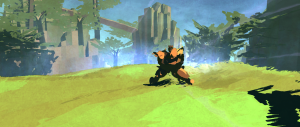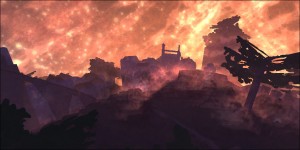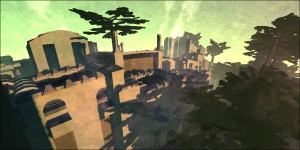Looking for Love
GDC (the Game Developers Conference) always plays host to a wealth of interesting game concepts, and this March GDC will feature a talk from independent developer Eskil Steenberg, whose indy mMO, Love, will take center stage. This will be the public’s first real look at the game of Love, which is an enigmatic, artistic project from an enigmatic artist who puts the devotion into development.
I call Love an mMO, because it begs comparison to mainstream MMOs, but it only allows 200 players to inhabit each server. It’s just a little less massive. The concept of Love is brilliantly simple: Players enter a world that has been procedurally generated and populated with AI inhabitants and various resources, tools, and other objects. Players can then find tokens which enable them to make or use objects, or they can engage in combat with each other or the AI inhabitants.

A player character in Love.
Steenberg intends the narrative of Love to be built by player actions. As players find tokens, build settlements, create ad-hoc alliances and civilizations, battle AI inhabitants, and alter the landscape, all of these actions are noted in the history of that instance of the game world. As other players move through the world they are informed of the actions of their predecessors. Steenberg insists in several ways on the Love website that when players return they will be just as interested in seeing what other players have done to alter the world as in taking part in some battle or adventure.
To enhance the community aspects of the game, all found resources are shared. If a player finds a token that makes a weapon available, they must use that token inside their settlement, which then gives that weapon to anyone in that settlement. To add to the complexity of the world, each object is controlled through an in-game mechanic that can be intercepted and manipulated. That is, some players can become good at “hacking” the objects in the world, thus increasing their overall social capital and assisting their chosen social circle.

A city in Love from a distance.
These are lofty, engaging ideas that gets game art fans interested. However, and in a disappointingly predictable move, most of the gaming press has focused on the graphics. A lot has been written about the visual appearance of Love, which does look a bit like an impressionistic painting mixed with early computer animation aesthetics. It has a visual style that is not at all mainstream gaming, but also not low tech or old-fashioned. It is utterly unique and wonderful because of it. That such engaging visuals can be created algorithmically is an accomplishment.
However, as with so many great ideas in the gaming world, Love so far does not really exist. Steenberg showed demos of his game engine to other developers and some media at GDC 2008. The tools Steenberg has used to build Love are interesting because it is an conglomeration of open source tools readily available to anyone and tools that Steenberg himself has created (those are open source, too, so anyone can play with the technology of Love).

Another city shot from Love.
Steenberg speaks eloquently about the development of Love. Heck, he even speaks eloquently about the Palestinian-Israeli conflict. Whether we see the milestone build of Love that Steenberg is hoping to produce in time for GDC 2009, or not, his talk is sure to be a fascinating discussion laced with both innovative ideas and a pure love of game development. And even if you’ve never been interested in an MMO before or you’re that MMO serial-monogamist, Love is something to look for in March.